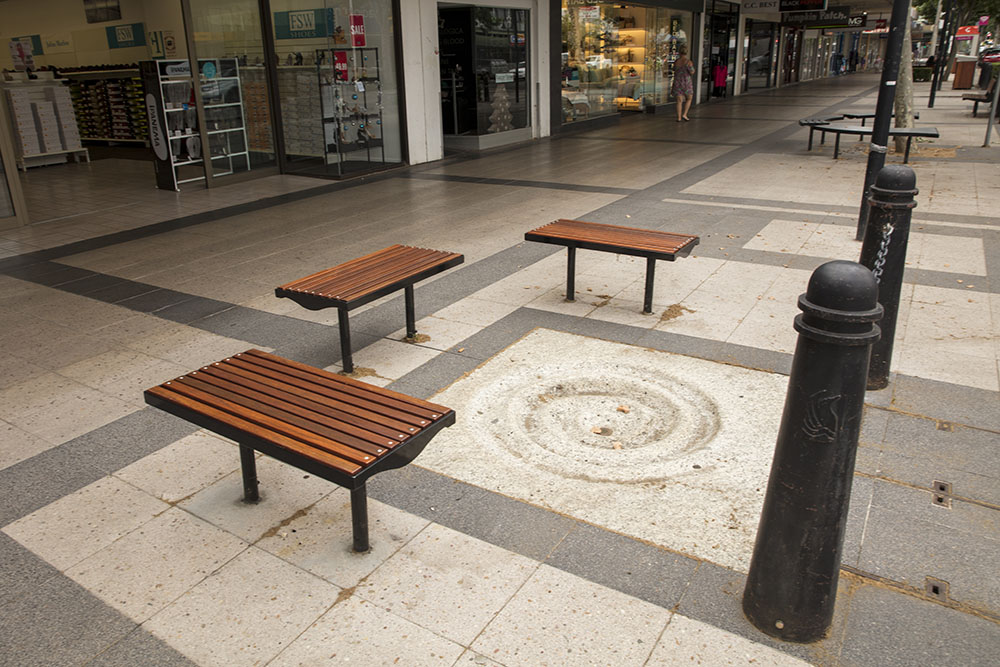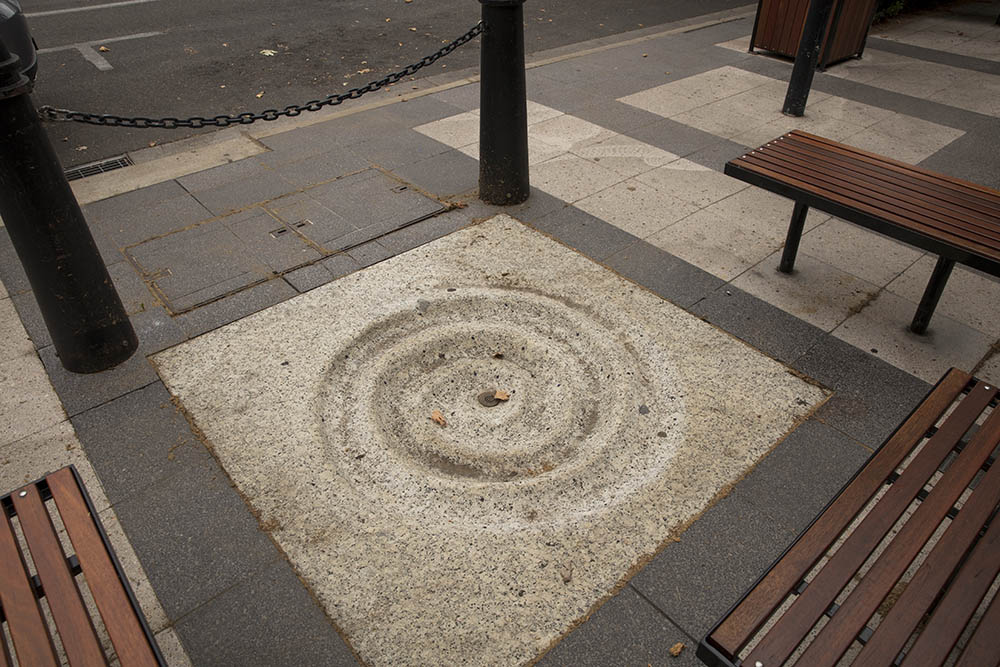Granite Rock
140 Baylis Street, Wagga Wagga
Public Art Audio Trail
Episode 9: Granite Spiral & Sculptural Seat
Episode 9 combines both Granite Spiral and Sculptural Seat.
Audio visual description - Granite Spiral:
Acknowledgement spoken by Bernard Higgins.
Narration, content and interview by Ashleigh Adams.
Sound and music by Sam Webber Sound.
Episode 9: Granite Spiral & Sculptural Seat, Snakes and Ladders, Hopscotch, Bluestone Boarders
Artist: Kim Barter, John Barter and Steven Williams
Baylis Street is home to several public artworks by artists Kim Barter, John Barter and Steven Williams. This talented team created five of the public artworks you will encounter as you make your way down Wagga Wagga’s main street. Inspired by local landscapes and topography, many of these pieces draw on the key features of Wagga Wagga’s unique surrounds.
John Barter and Steven Williams also created the little crows that sit on top of the street signs along Baylis Street, see how many you can spot along the way.
Half-way along the western side of the block between Thompson and Forsyth Streets, watch out for the whirlpool that has surfaced in the pavement. This work, titled Granite Spiral was inspired by the ‘eddy' – a small circular current that forms in a river when the main current becomes pinched off by rocks or logs. The Murrumbidgee River runs parallel to Baylis Street, and this work makes the playful suggestion that one of these eddy’s has emerged right here on the footpath!
Not far from the Granite Spiral is the Sculptural Seat, another public artwork that pays homage to the river system of the Murrumbidgee. The peculiar shape of Sculptural Seat is modelled after an anabranch, which is a billabong that flows into a river. The work appears from some angles like a wave frozen in time as the world moves swiftly past. But if you look closely, the signature symbols of the trio’s mosaic pieces’ prompt us to ponder the hidden meaning behind each tile.
Artist Kim Barter is going to tell us all about the process behind creating this series of public artworks:
Some of these works along Baylis Street were created in a collaboration between yourself and artists John Barter and Steven Williams, what were each of your roles when it came to the design and creation of these works?
We all brought various skills to the project, and we also included local manufactures and producers along the way because we didn’t have the skills that required um the major undertaking to fulfill the brief, for instance the Wagga Foundry was are made the crows the iron crows that appear on the street signs and these um granite spiral was made in the workshop of John Shepherd the stone mason. Steve was a potter a local woodfired potter and a master of all mixed media works, and John and I cross a few different mediums, but we basically made the tiles and buy them and came up with various designs and worked with the various manufactures to fulfill the brief I suppose.
Can you tell us about the process of handcrafting and laying all of those tiny multi-coloured tiles?
The tiles, Steve made a huge array of coloured clays, so there was yellow, green, cobalt blue and black as well as the terracotta and white. We decided that regardless of the wear and tear of the pavement over time you would constantly always see a colour. At that stage the old Civic Theatre was abandoned and waiting for discussion to see what would happen, I used the foyer as my studio and I put down huge down pieces of plywood and laboriously placed every little tile on its matrix and then I stuck brown paper to the backings of it all so that I could pass that onto the tiler and let him go for it.
There is a common theme of symbols, letters or numbers that occur throughout the mosaic works, what was the inspiration behind those and what do they each mean?
There are circles and circles are pretty much a major symbol for First Nations people which means water hole, so the Murrumbidgee River is close by, so we always intended to recognise that. The seat and the bluestone waters a lot of the designs there were aerial views of Wagga which are amazing when you actually look out on satellite and look down and see all the various patterns and the eddy’s and the shapes and symbols and also we, I was always referencing the foot, the tessellated tiles that are in Best Street and Peter Street and the beautiful homes that are behind there have the amazing verandah tiled verandahs, so I was basically thought ok the foot sees a lot of surfaces that its tracing around and thinking about the shoe or the foots journey during the day.
At the Thompson and Forsyth street intersections along Baylis Street, keep an eye out for the mosaic works embedded in the footpath. They are titled Snakes and Ladders, Hopscotch and Bluestone Boarders. These artworks feature pools of colour, metal animals and patterns invoking the local landscape. The artists goal was to capture children’s attention for a moment and instigate their own play.
Granite Spiral:
The granite spiral is a three-dimensional artwork carved into the pavement. The spiral shape is centred on one square section of concrete. The round spiral shape swirls clockwise and is made of smooth, swirling indents in the concrete that meet at the small drain in the centre. When water is poured into the granite spiral it follows these grooves into the centre and drains away.
Sculptural Seat:
The sculptural seat is a large curved almost S-shaped bench covered in small tiles no bigger than a 20c coin. The bench sits flush with the ground and is one solid shape. The tiles covering the surface of the sculpture are dark blue with some shapes and patterns in red, yellow, black and white tiles. These patterns are arrows, X shapes, squares and lines. The bench has rounded edges, no corners and has a ledge for sitting on both sides of the S. The top of these two sitting ledges are covered in light blue tiles.
Explore the Trail
This artwork is a part of the Public Art Audio Trail, follow the link below to see all the artworks on the trail.
About the Artwork
Granite spiral was inspired by 'the eddy'. The Murrumbidgee River runs parallel to Baylis Street, a significant body of water with a significant current. A beautiful natural asset that is hidden from the city by levee banks, due to infrequent flooding.
The river is a contrast of the built environment versus the natural world. The eddy alludes to this river system, where waters spiral and swirl around tree roots and limbs, and the surface breaks due to fish and birds feeding.
Kim Barter
Kim Barter is a painter and printmaker living in Central Victoria, known for her expressive and often visceral responses to the landscape. Barter works en plein air with her sketchbook, often camping for lengths of time to paint, trace, sketch and immerse herself as a true resident of her wild surroundings.
Barter has a Bachelor of Visual Arts with a major in Textiles from the Charles Sturt University where she lectured throughout her early career in Printed Textiles and Drawing. Since the mid 1980's Barter has exhibited throughout Australia including notable exhibitions at Linden Contemporary, Libby Edwards Gallery, Australian Galleries, the Albury Regional Gallery and Stockroom.
Her work has been shortlisted for the Stan and Maureen Duke Gold Coast Prize and the Frankston Art Prize and commissioned by Wagga Wagga City Council, and the the Print Council of Australia, Wagga Wagga City Council. Collections include the Wagga Wagga Regional Gallery, Ararat Art Gallery and Private collections in Australia, Finland, Hong Kong, Japan and the Netherlands.
John Barter
John Barter works with weather beaten recycled tin, crumpled and sometimes rusted. He enjoys the relatively small scale of his work, the individuality inherent to each patina and the way his work becomes parts of people’s lives. Barter draws simple shapes onto tin, cuts and shapes by hand, allowing for a rawness in the construction, and an integrity in appearance. His work often reflects a sense of humour.
The Australian vernacular of ‘making-do’ has always been an inspiration for Barter’s work whereby a need is met by ones improvised 3ingenuity. Barter’s work can be found in public and private collections in Australia, New Zealand, the Netherlands and the United States of America.
Steven Williams
Steven has completed Post Graduate in Ceramic Design studies. He is a full time teacher of Ceramics at TAFE and is the acting teacher in charge of the Art Department.
Steven has exhibited throughout Australia and still continues to work collaboratively on community projects, while building much experience in wood firing and kiln building. Steven's collaborative Wagga Wagga public artworks are titled Walking Surfaces, Granite Spiral, Sculptural Seat, Bangayarra Walkway, Snakes and Ladders, Bluestone Boarders 1999, Bluestone Boarders 2000 and Hopscotch.


